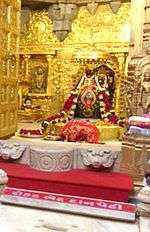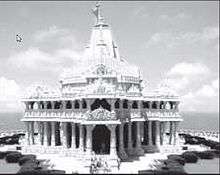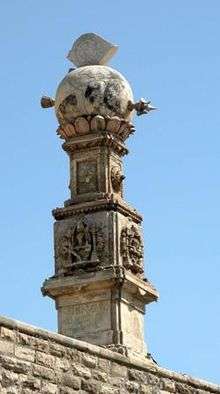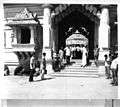Somnath temple
| Somnath Temple | |
|---|---|
|
Front view of the present Somnath Temple | |
 Somnath Temple Location within Gujarat | |
| Name | |
| Proper name | Somnath Temple |
| Devanagari | सोमनाथ मन्दिर |
| Sanskrit transliteration | Sōmanātha mandira |
| Gujarati | સોમનાથ મંદિર |
| Geography | |
| Coordinates | 20°53′16.9″N 70°24′5.0″E / 20.888028°N 70.401389°ECoordinates: 20°53′16.9″N 70°24′5.0″E / 20.888028°N 70.401389°E |
| Country | India |
| State/province | Gujarat |
| District | Gir Somnath |
| Locale | Prabhas Patan, Veraval |
| Culture | |
| Primary deity | Somnath (Shiva) |
| Important festivals | Maha Shivaratri |
| Architecture | |
| Architectural styles | Hindu temple architecture |
| History and governance | |
| Date built | 1951 (present structure) |
| Temple board | Shree Somnath Trust of Gujarat |
| Website |
www |
The Somnath temple located in Prabhas Patan near Veraval in Saurashtra on the western coast of Gujarat, is believed to be the first among the twelve jyotirlinga shrines of Shiva.[1] It is an important pilgrimage and tourist spot of Gujarat. Destroyed and reconstructed several times in the past, the present temple was reconstructed in Chalukya style of Hindu temple architecture and completed in May 1951. The reconstruction was envisioned by Vallabhbhai Patel and was completed under K. M. Munshi, the then head of the temple trust.[2][3]
Etymology
The temple is considered sacred due to the various legends connected to it. Somnath means "Lord of the Soma", an epithet of Shiva.
The Somnath temple is known as "the Shrine Eternal", following a book of K. M. Munshi by this title and his narration of the temple's destruction and reconstruction many times in history.[4]
Jyotirlinga

According to tradition, the Shivalinga in Somnath is one of the twelve jyotirlingas in India, where Shiva is believed to have appeared as a fiery column of light. The jyotirlingas are taken as the supreme, undivided reality out of which Shiva partly appears.[5][6]
Each of the twelve jyotirlinga sites take the name of a different manifestation of Shiva.[7] At all these sites, the primary image is a lingam representing the beginning-less and endless stambha (pillar), symbolizing the infinite nature of Shiva.[7][8][9] In addition to the one at Somnath, the others are at Varanasi, Rameswaram, Dwarka, etc.[10][11]
History
The site of Somnath has been a pilgrimage site from ancient times on account of being a Triveni sangam (the confluence of three rivers — Kapila, Hiran and the mythical Sarasvati). Soma, the Moon god, is believed to have lost his lustre due to a curse, and he bathed in the Sarasvati River at this site to regain it. The result is the waxing and waning of the moon, no doubt an allusion to the waxing and waning of the tides at this sea shore location. The name of the town Prabhas, meaning lustre, as well as the alternative names Someshvar and Somnath ("The lord of the moon" or "the moon god") arise from this tradition.[12]
History of the temple
According to popular tradition documented by J. Gordon Melton, the first Siva temple at Somanath is believed to have been built at some unknown time in the past. The second temple is said to have been built at the same site by the "Yadava kings" of Vallabhi around 649 CE. In 725 CE, Al-Junayd, the Arab governor of Sindh is said to have destroyed the second temple as part of his invasions of Gujarat and Rajasthan. The Gurjara-Pratihara king Nagabhata II is said to have constructed the third temple in 815 CE, a large structure of red sandstone.[13]
However, there is no historical record of an attack on Somnath by Al-Junayd. Nagabhata II is known to have visited tirthas in Saurashtra, including Someshvara (the Lord of the Moon), which may or may not be a reference to a Siva temple because the town itself was known by that name.[14] The Chaulukya (Solanki) king Mularaja possibly built the first temple at the site sometime before 997 CE, even though some historians believe that he may have renovated a smaller earlier temple.[15]
.jpg)
In 1024, during the reign of Bhima I, the prominent Turkic ruler Mahmud of Ghazni raided Gujarat, plundering the Somnath temple and breaking its jyotirlinga. He took away a booty of 20 million dinars.[16][17] Historians expect the damage to the temple to have been minimal because there are records of pilgrimages to the temple in 1038, which make no mention of any damage to the temple.[18] However, powerful legends with intricate detail developed in the Turko-Persian literature regarding Mahmud's raid,[19] which "electrified" the Muslim world according to scholar Meenakshi Jain.[20]
The temple at the time of Mahmud's attack appears to have been a wooden structure, which is said to have decayed in time (kalajirnam). Kumarapala (r. 1143–72) rebuilt it in "excellent stone and studded it with jewels," according to an inscription in 1169.[21][22] In 1299, Alauddin Khilji's army under the leadership of Ulugh Khan defeated Karandev II of the Vaghela dynasty, and sacked the Somnath temple.[23] According to Taj-ul-Ma'sir of Hasan Nizami, the Sultan boasted that "fifty thousand infidels were dispatched to hell by the sword" and "more than twenty thousand slaves, and cattle beyond all calculation fell into the hands of the victors". Kanhadadeva the Raja of Jalore later defeated the Khilji army, recovered the broken pieces of the lingam and freed the prisoners.[24][25]
The temple was rebuilt by Mahipala Deva, the Chudasama king of Saurashtra in 1308 and the lingam was installed by his son Khengar sometime between 1326 and 1351.[26] As late as the 14th century, Gujarati Muslim pilgrims were noted by Amir Khusrow to stop at that temple to pay their respects before departing for the Hajj pilgrimage.[27]
In 1395, the temple was destroyed for the third time by Zafar Khan, the last governor of Gujarat under the Delhi Sultanate.[28] In 1451, it was desecrated by Mahmud Begada, the Sultan of Gujarat.[29]
In 1546, the Portuguese, based in Goa, attacked ports and towns in Gujarat including Somnath and destroyed several temples and mosques.[30]
By 1665, the temple, one of many, was ordered to be destroyed by Mughal emperor Aurangzeb.[31] In 1702, he ordered that if Hindus revived worship there, it should be demolished completely.[32]
'Proclamation of the Gates' incident during the British period
In 1782-83 AD, Maratha king Mahadaji Shinde, victoriously brought back three silver gates from Lahore after defeating Mahmud Shah Abdati, to Somnath. After refusal from priests of Gujarat and the then ruler Gaekwad to put them back on Somnath temple, these silver gates were placed in the temples of Ujjain. Today they can be seen in two temples of India, Mahakaleshwar Jyotirlinga and Gopal Mandir of Ujjain.[33][34][35]
In 1842, Edward Law, 1st Earl of Ellenborough issued his the Proclamation of the Gates, in which he ordered the British army in Afghanistan to return via Ghazni and bring back to India the sandalwood gates from the tomb of Mahmud of Ghazni in Ghazni, Afghanistan. These were believed to have been taken by Mahmud from Somnath. There was a debate in the House of Commons in London in 1843 on the question of the gates of the temple.[36][37] After much crossfire between the British Government and the opposition, the gates were uprooted and brought back in triumph. But on arrival, they were found to be replicas of the original.[34] They were placed in a store-room in the Agra Fort where they still lie to the present day.[38][39]
In the 19th century novel The Moonstone by Wilkie Collins, the diamond of the title is presumed to have been stolen from the temple at Somnath and, according to the historian Romila Thapar, reflects the interest aroused in Britain by the gates.[40]
Reconstruction, 1950–1951


Before independence, Prabhas Patan was part of the princely state of Junagadh, whose ruler had acceded to Pakistan in 1947. After India refused to accept his decision, the state was made a part of India and Deputy Prime Minister Patel came to Junagadh on 12 November 1947 to direct the stabilization of the state by the Indian Army and at the same time ordered the reconstruction of the Somanath temple.[41]
When Patel, K. M. Munshi and other leaders of the Congress went to Mahatma Gandhi with their proposal to reconstruct the Somnath temple, Gandhi blessed the move, but suggested that the funds for the construction should be collected from the public and the temple should not be funded by the state. He expressed that he was proud to associate himself to the project of renovation of the temple.[42] However, soon both Gandhi and Sardar Patel died and the task of reconstruction of the temple continued under Munshi, who was the Minister for Food and Civil Supplies, Government of India headed by Prime Minister Jawaharlal Nehru.[42]
The ruins were pulled down in October 1950 and the mosque present at that site was shifted few kilometres away.[43] In May 1951, Rajendra Prasad, the first President of the Republic of India, invited by K M Munshi, performed the installation ceremony for the temple.[44] The President said in his address, "It is my view that the reconstruction of the Somnath Temple will be complete on that day when not only a magnificent edifice will arise on this foundation, but the mansion of India's prosperity will be really that prosperity of which the ancient temple of Somnath was a symbol.".[45] He added "The Somnath temple signifies that the power of reconstruction is always greater than the power of destruction"[45]
Architecture of the present temple

The present temple is built in the Chalukya style of temple architecture or "Kailash Mahameru Prasad" style[46] and reflects the skill of the Sompura Salats, one of Gujarat's master masons. The temple's śikhara, or main spire, is 15 metres in height, and it has an 8.2-metre tall flag pole at the top.[46]
The temple is situated at such a place that there is no land in a straight line between Somnath seashore until Antarctica, such an inscription in Sanskrit is found on the Bāṇastambha (Sanskrit: बाणस्तम्भ, lit. arrow pillar) erected on the sea-protection wall. The Bāṇastambha mentions that it stands at a point on the Indian landmass that is the first point on land in the north to the South Pole at that particular longitude.[47]
Gallery
 Somnath Temple in 1957
Somnath Temple in 1957 Somnath Temple in 2012
Somnath Temple in 2012- Somnath Temple at dawn
See also
- Prabhas Patan
- Bhalka
- Conversion of non-Muslim places of worship into mosques
- Kashi Vishwanath Temple
Notes
- ↑ "Somnath darshan". Official website of Somnath Temple. Retrieved 19 December 2016.
- ↑ Gopal, Ram (1994). Hindu culture during and after Muslim rule: survival and subsequent challenges. M.D. Publications Pvt. Ltd. p. 148. ISBN 81-85880-26-3.
- ↑ Jaffrelot, Christophe (1996). The Hindu nationalist movement and Indian politics: 1925 to the 1990s. C. Hurst & Co. Publishers. p. 84. ISBN 1-85065-170-1.
- ↑ Ranjan Ghosh (30 June 2012). A Lover's Quarrel with the Past: Romance, Representation, Reading. Berghahn Books. pp. 54–. ISBN 978-0-85745-485-0.
- ↑ Eck 1999, p. 107
- ↑ See: Gwynne 2008, Section on Char Dham
- 1 2 Lochtefeld 2002, pp. 324-325
- ↑ Harding 1998, pp. 158-158
- ↑ Vivekananda Vol. 4
- ↑ Venugopalam 2003, pp. 92–95.
- ↑ Chaturvedi 2006, pp. 58–72.
- ↑ Thapar 2004, p. 18.
- ↑ Melton, J. Gordon (2014). Faiths Across Time: 5,000 Years of Religious History. ABC-CLIO. pp. 516, 547, 587. ISBN 1610690265.
- ↑ Dhaky & Shastri 1974, p. 32 cited in Thapar 2004, p. 23
- ↑ Thapar 2004, pp. 23-24.
- ↑ Yagnik & Sheth 2005, pp. 39-40.
- ↑ Thapar 2004, pp. 36-37.
- ↑ Thapar 2004, p. 75.
- ↑ Thapar 2004, Chapter 3.
- ↑ Meenakshi Jain (21 March 2004). "Review of Romila Thapar's "Somanatha, The Many Voices of a History"". The Pioneer. Retrieved 2014-12-15.
- ↑ Thapar 2004, p. 79.
- ↑ Yagnik & Sheth 2005, p. 40.
- ↑ Yagnik & Sheth 2005, p. 47.
- ↑ Maheshwari, Hiralal (1980). History of Rajasthani Literature. Sahitya Akademi. p. 17.
- ↑ Panhwar, M. H. (1984–85). "The development in the study of history and archaeology of Sindh" (PDF). Sindhological Studies. 8–9. Retrieved 2008-03-31.
- ↑ Temples of India. Prabhat Prakashan. Retrieved 1 November 2014.
- ↑ Flood, Finbarr Barry (2009). Objects of Translation: Material Culture and Medieval "Hindu-Muslim" Encounter. Princeton University Press. p. 43. ISBN 9780691125947.
- ↑ Yagnik & Sheth 2005, p. 49.
- ↑ Yagnik & Sheth 2005, p. 50.
- ↑ Yagnik & Sheth 2005, p. 52.
- ↑ Satish Chandra, Medieval India: From Sultanat to the Mughals, (Har-Anand, 2009), 278.
- ↑ Yagnik & Sheth 2005, p. 55.
- ↑ Amitabh Mishra (1 January 2007). Heritage Tourism in Central India: Resource Interpretation and Sustainable Development Planning. Kanishka Publishers, Distributors. p. 42. ISBN 978-81-7391-918-3.
- 1 2 "Mosque and Tomb of the Emperor Sultan Mahmood of Ghuznee". British Library. Retrieved 1 November 2014.
- ↑ 101 pilgrimages. Outlook India Pub. 2006. p. 79.
- ↑ The United Kingdom House of Commons Debate, 9 March 1943, on The Somnath (Prabhas Patan) Proclamation, Junagadh 1948. 584-602, 620, 630-32, 656, 674.
- ↑ "The Gates of Somnauth, by Thomas Babington Macaulay, a speech in the House of Commons, March 9, 1843". Columbia University in the City of New York. Retrieved 5 August 2016.
- ↑ John Clark Marshman (1867). The History of India, from the Earliest Period to the Close of Lord Dalhousie's Administration. Longmans, Green. pp. 230–231.
- ↑ George Smith (1878). The Life of John Wilson, D.D. F.R.S.: For Fifty Years Philanthropist and Scholar in the East. John Murray. pp. 304–310.
- ↑ Thapar 2004, p. 170
- ↑ Hindustan Times, 15 Nov, 1947
- 1 2 Marie Cruz Gabriel, Rediscovery of India, A silence in the city and other stories, Published by Orient Blackswan, 1996, ISBN 81-250-0828-4, ISBN 978-81-250-0828-6
- ↑ Mir Jaffar Barkriwala, The Glorious Destruction of Hindoo Temples in Kathiawar and their replacement, Ul Akbari Publications, Bharuch, 1902
- ↑ Peter Van der Veer, Ayodhya and Somnath, eternel shrines, contested histories, 1992
- 1 2 Kanaiyalal Maneklal Munshi, Indian constitutional documents, Published by Bharatiya Vidya Bhavan, 1967
- 1 2 "Shree Somnath Trust :: Jay Somnath". Somnath.org. Retrieved 1 November 2014.
- ↑ "Somnath Temple - ~ Fun With Best Friends ~". Indianfriendhood.in. Retrieved 1 November 2014.
References
- Chaturvedi, B. K. (2006), Shiv Purana (First ed.), New Delhi: Diamond Pocket Books (P) Ltd, ISBN 81-7182-721-7
- Eck, Diana L. (1999), Banaras, city of light (First ed.), New York: Columbia University Press, ISBN 0-231-11447-8
- Gwynne, Paul (2009), World Religions in Practice: A Comparative Introduction, Oxford: Blackwell Publication, ISBN 978-1-4051-6702-4.
- Harding, Elizabeth U. (1998). "God, the Father". Kali: The Black Goddess of Dakshineswar. Motilal Banarsidass. pp. 156–157. ISBN 978-81-208-1450-9.
- Lochtefeld, James G. (2002), The Illustrated Encyclopedia of Hinduism: A-M, Rosen Publishing Group, p. 122, ISBN 0-8239-3179-X
- Venugopalam, R. (2003), Meditation: Any Time Any Where (First ed.), Delhi: B. Jain Publishers (P) Ltd., ISBN 81-8056-373-1
- Vivekananda, Swami. "The Paris Congress of the History of Religions". The Complete Works of Swami Vivekananda. Vol.4.
- Thapar, Romila (2004). Somanatha: The Many Voices of a History. Penguin Books India. ISBN 1-84467-020-1.
- Yagnik, Achyut; Sheth, Suchitra (2005), The Shaping of Modern Gujarat: Plurality, Hindutva, and Beyond, Penguin Books India, p. 39, ISBN 978-0-14-400038-8
- Dhaky, M. A.; Shastri, H. P., eds. (1974). The Riddle of the Temple at Somanatha. Bharata Manisha.
- Henry, Cousens (1931), Somnatha and Other Mediaeval Temples in Kathiawad, India: Archaeological Survey of India, Vol XLV, Imperial Press
External links
| Wikimedia Commons has media related to Somnath temple. |

